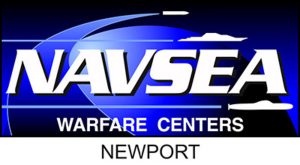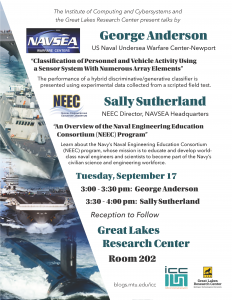
Timothy Havens, the William and Gloria Jackson Associate Professor of Computer Systems, has co-authored a paper recently published in The Journal of the Acoustical Society of America, Volume 50, Issue 1.
The paper is titled, “Recurrent networks for direction-of-arrival identification of an acoustic source in a shallow water channel using a vector sensor.” Havens’s co-authors are Steven Whitaker (EE graduate student), Andrew Barnard (ME-EM/GLRC), and George D, Anderson, US Naval Undersea Warfare Center (NUWC)-Newport.
The work described in the paper was funded by the United States Naval Undersea Warfare Center and Naval Engineering Education Consortium (NEEC) (Grant No. N00174-19-1-0004) and the Office of Naval Research (ONR) (Grant No. N00014-20-1-2793). This is Contribution No. 76 of the Great Lakes Research Center at Michigan Technological University.
Abstract
Conventional direction-of-arrival (DOA) estimation algorithms for shallow water environments usually contain high amounts of error due to the presence of many acoustic reflective surfaces and scattering fields. Utilizing data from a single acoustic vector sensor, the magnitude and DOA of an acoustic signature can be estimated; as such, DOA algorithms are used to reduce the error in these estimations.
Three experiments were conducted using a moving boat as an acoustic target in a waterway in Houghton, Michigan. The shallow and narrow waterway is a complex and non-linear environment for DOA estimation. This paper compares minimizing DOA errors using conventional and machine learning algorithms. The conventional algorithm uses frequency-masking averaging, and the machine learning algorithms incorporate two recurrent neural network architectures, one shallow and one deep network.
Results show that the deep neural network models the shallow water environment better than the shallow neural network, and both networks are superior in performance to the frequency-masking average method.
Citation: The Journal of the Acoustical Society of America 150, 111 (2021); https://doi.org/10.1121/10.0005536Steven Whitaker1,b), Andrew Barnard2, George D. Anderson3, and Timothy C. Havens4

The U.S. Department of Defense, Office of Naval Research, has awarded Michigan Tech faculty researchers a $249,000 grant that supports the creation of an ROTC undergraduate science and engineering research program at Michigan Tech. The primary goal of the program is to supply prepared cadets to all military branches to serve as officers in Cyber commands.
The principal investigator (PI) of the project is Andrew Barnard, Mechanical Engineering-Engineering Mechanics. Co-PIs are Timothy Havens, College of Computing; Laura Brown , Computer Science, and Yu Cai, Applied Computing. The title of the project is, “Defending the Nation’s Digital Frontier: Cybersecurity Training for Tomorrow’s Officers.”
The curriculum will be developed over the summer, and instruction associated with the award will begin in the fall 2020 semester. Cadets interested in joining the new program are urged to contact Andrew Barnard.
Initially, the program will focus on topics in cybersecurity, machine learning and artificial intelligence, data science, and remote sensing systems, all critical to the The Naval Science and Technology (S&T) Strategic Plan and the Navy’s Force of the Future, and with equal relevance in all branches of the armed forces.
The plan of work focuses on on engaging ROTC students in current and on-going Cyber research, and supports recruitment of young ROTC engineers and scientists to serve in Navy cybersecurity and cyber-systems commands. The program will compel cadets to seek positions within Cyber commands upon graduation, or pursue graduate research in Cyber fields.
“Our approach develops paid, research-based instruction for ROTC students through the existing Michigan Tech Strategic Education Naval Systems Experiences (SENSE) program,” said principal investigator Andrew Barnard, “ROTC students will receive one academic year of instruction in four Cyber domains: cybersecurity, machine learning and artificial intelligence (ML/AI), data science, and remote sensing systems.”
Barnard says the cohort-based program will enrich student learning through deep shared research experiences. He says the program will be designed with flexibility and agility in mind to quickly adapt to new and emerging Navy science and technology needs in the Cyber domain.
Placement of officers in Cyber commands is of critical long-term importance to the Navy (and other DoD branches) in maintaining technological superiority, says the award abstract, noting that technological superiority directly influences the capability and safety of the warfighter.
Also closely involved in the project are Michigan Tech Air Force and Army ROTC officers Lt. Col. John O’Kane and LTC Christian Thompson, respectively.
“Unfortunately, many ROTC cadets are either unaware of Cyber related careers, or are unprepared for problems facing Cyber officers,” said Lt. Col. O’Kane. “This proposal aims to provide a steady flow of highly motivated and trained uniformed officers to the armed-services, capable of supporting the warfighter on day-one.”
Andrew Barnard is director of Michigan Tech’s Great Lakes Research Center, an associate professor of Mechanical Engineering-Engineering Mechanics, and faculty advisor to the SENSE Enterprise.
Tim Havens is director of the Institute of Computing and Cybersystems, associate dean for research, College of Computing, and the William and Gloria Jackson Associate Professor of Computer Systems.
Laura Brown is an associate professor, Computer Science, director of the Data Science graduate program, and a member of the ICC’s Center for Data Sciences.
Yu Cai is a professor of Applied Computing, an affiliated professor of Computational Science and Engineering, a member of the ICC’s Center for Cybersecurity, and faculty advisor for the Red Team, which competes in the National Cyber League (NCL).
The Great Lakes Research Center (GLRC) provides state-of-the-art laboratories to support research on a broad array of topics. Faculty members from many departments across Michigan Technological University’s campus collaborate on interdisciplinary research, ranging from air–water interactions to biogeochemistry to food web relationships.
The Army and Air Force have active ROTC programs on Michigan Tech’s campus.
The Office of Naval Research (ONR) coordinates, executes, and promotes the science and technology programs of the United States Navy and Marine Corps.
 George Anderson and Sally Sutherland of the US Naval Undersea Warfare Center (NUWC)-Newport will present talks on Tuesday, September 17, 2019, from 3:00 to 4:00 pm, in Room 202 of the Michigan Tech Great Lakes Research Center. A reception will follow and refreshments will be served.
George Anderson and Sally Sutherland of the US Naval Undersea Warfare Center (NUWC)-Newport will present talks on Tuesday, September 17, 2019, from 3:00 to 4:00 pm, in Room 202 of the Michigan Tech Great Lakes Research Center. A reception will follow and refreshments will be served.
George Anderson will present his talk from 3:00 – 3:30 pm. Titled “Classification of Personnel and Vehicle Activity Using a Sensor System With Numerous Array Elements,” Anderson’s talk will present the performance of a hybrid discriminative/generative classifier using experimental data collected from a scripted field test.
Sally Sutherland, NEEC Director, NAVSEA Headquarters, whose talk is 3:30-4:00 pm, will present, “An Overview of the Naval Engineering Education Consortium (NEEC) Program,” in which she will share information about the Navy’s Naval Engineering Education Consortium (NEEC) program, whose mission is to educate and develop world-class naval engineers and scientists to become part of the Navy’s civilian science and engineering workforce.